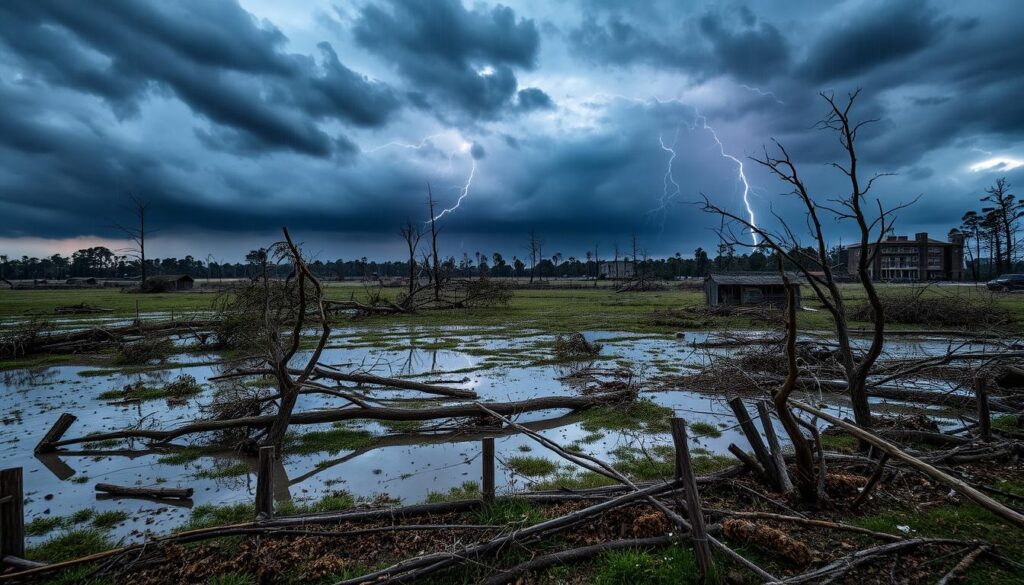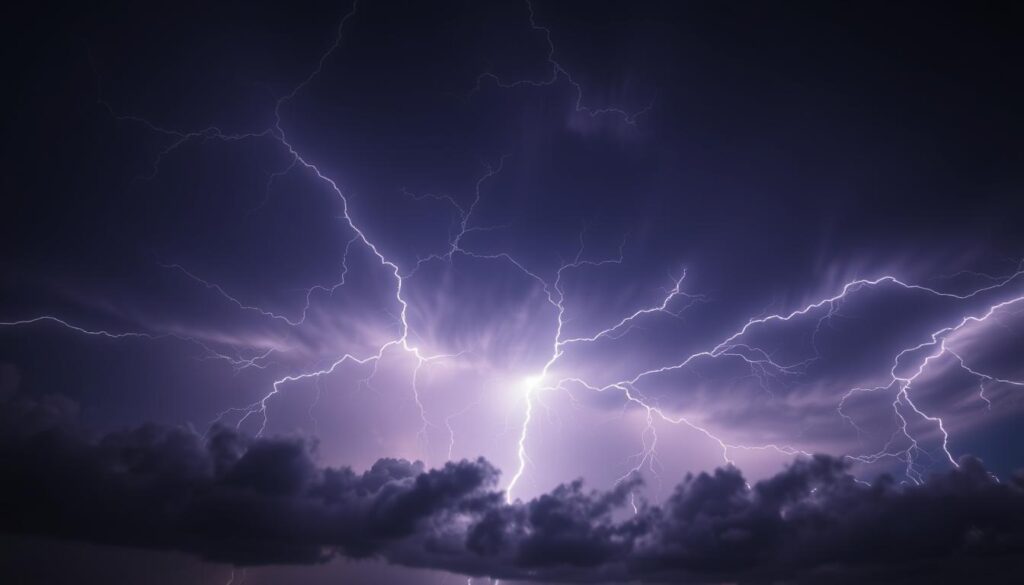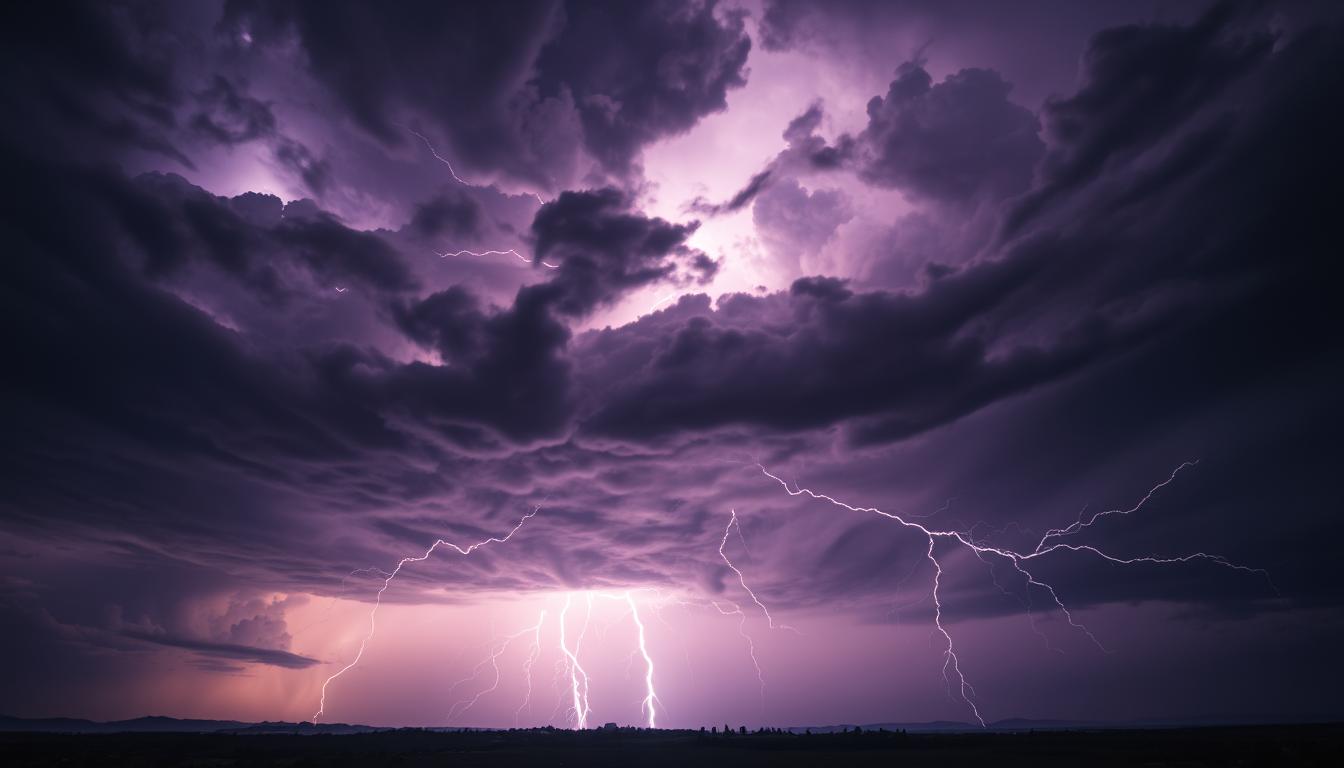Dark clouds gathered overhead, and a sudden crackle of electricity split the air. A blinding flash lit up the sky, revealing the power of thunderbolts. For centuries, these electrifying displays have amazed humanity. From ancient Greeks seeing Zeus’s wrath to today’s onlookers, they are a testament to nature’s beauty.
In the midst of a thunderstorm, lightning strikes and electric discharges happen. They are the result of atmospheric electricity building up and then releasing. These high voltage phenomena create dazzling displays of light and sound. They leave onlookers both captivated and humbled by nature’s fury.
Thunderbolts are seen as divine wrath or a display of nature’s incredible forces. They are a marvel of the natural world. Let’s explore the science, history, and cultural significance of these electric discharges. We’ll delve into what makes them so inspiring and fascinating to generations.
Key Takeaways
- Thunderbolts, also known as lightning, are awe-inspiring atmospheric phenomena that captivate humanity with their raw power and beauty.
- These electric discharges are the result of the buildup and release of static electricity within thunderstorms, creating dazzling displays of light and sound.
- Thunderbolts have long been associated with the wrath of the gods, such as Zeus in Greek mythology, and continue to inspire wonder and fascination in the modern world.
- The science behind thunderbolts involves complex atmospheric processes, including the formation of lightning strikes and the unique characteristics of these high voltage phenomena.
- Thunderstorm events and their impact on the environment, as well as historical accounts and cultural significance, contribute to the enduring fascination with thunderbolts.
Introduction to Thunderbolts
Thunderbolts, the mesmerizing electrical discharges that occur during thunderstorms, have long fascinated humans. These powerful lightning bolts can reach temperatures of up to 50,000°F (27,700°C). They are the result of the buildup of atmospheric electricity in the skies above us.
What are Thunderbolts?
Thunderbolts, also known as lightning, are the visible manifestation of the sudden release of static electricity. When the electrical charge difference between clouds and the ground is great enough, the air acts as a conductive pathway. This allows the electricity to discharge in the form of a blinding electric discharge.
The Awe-Inspiring Spectacle of Lightning
The sight of these thunderbolts streaking across the sky, often accompanied by the booming sound of thunder, is awe-inspiring. These natural phenomena showcase the raw power and beauty of the natural world. They remind us of the awesome forces that shape our planet.
“The lightning flashes through my skull; mine eyeballs ache and ache; my whole beaten brain seems as beheaded, and rolling on some stunning ground.”
– Herman Melville, Moby Dick
The Fascinating Science Behind Thunderbolts
The awe-inspiring display of thunderbolts stems from the complex science of atmospheric electricity. Warm, moist air rises, cools, and condenses into clouds. The movement of water droplets and ice crystals within these clouds creates an imbalance of positive and negative charges.
Atmospheric Electricity and Charge Buildup
This separation of charges, combined with the intense electrical fields in the storm, is crucial for lightning formation. The rising and falling of water particles inside the cloud generates a lot of atmospheric electricity. This leads to a significant charge buildup between the cloud’s different regions and the ground below.
The Formation of Lightning Strikes
When the electrical field becomes strong enough, it breaks through the air’s insulating properties. This causes the lightning formation. The sudden release of this electrical energy as a lightning bolt is what we call a thunderbolt. It’s a dazzling and powerful display of nature’s thunderbolt science and electrostatic discharge.
“The lightning flash is the visible part of a large-scale electrostatic discharge within a thundercloud or between a thundercloud and the ground.”
The process of thunderbolt formation is a testament to the incredible power and complexity of our natural world. It showcases the remarkable workings of atmospheric electricity and charge buildup within these awe-inspiring storm systems.
thunderbolts
The world of thunderbolts is filled with a variety of lightning discharges, each with its own distinct traits. From the common negative and positive lightning to the enigmatic ball lightning and upward lightning, these phenomena offer a captivating look into the power of atmospheric electricity.
Types of Lightning Discharges
Negative lightning is the most common, starting from the negatively charged base of a thundercloud and striking the ground. In contrast, positive lightning comes from the positively charged upper storm regions, often delivering a more powerful and dangerous discharge.
Ball lightning and upward lightning add mystery to the thunderbolt spectrum. Ball lightning is a rare phenomenon that appears as a glowing sphere, floating or hovering through the air. Upward lightning, less common, starts from tall structures or mountains, traveling upward to meet the descending leader from the cloud.
Unique Characteristics of Thunderbolts
- Intense heat, with temperatures reaching up to 54,000°F (30,000°C)
- Bright luminosity that can momentarily outshine the sun
- Powerful shockwaves that can cause structural damage and acoustic effects
- Rapid discharge, with lightning bolts traveling at over 200,000 mph (320,000 km/h)
Thunderbolts’ captivating characteristics and diverse forms make them a subject of both study and admiration. Scientists, photographers, and nature enthusiasts find them fascinating.
Thunderstorm Events and Their Impact
The power of thunderstorms is undeniable, often leading to devastating thunderstorm events with far-reaching consequences. These intense disturbances can unleash a barrage of thunderbolt impacts. This causes substantial storm damage to property, infrastructures, and human lives.
Thunderstorms pose a significant threat with the potential for power outages. The electrical activity within these storms can disrupt power grids. This leaves communities in the dark, disrupting vital services. Such disruptions can hinder communication, transportation, and daily operations of businesses and households.
The safety concerns associated with thunderstorms are also critical. Lightning strikes, a hallmark of these events, can pose a serious risk to individuals. This can lead to injury or even fatality. Heavy rainfall, strong winds, and hail can also create dangerous conditions, requiring swift action and precautions.
| Thunderstorm Impact | Potential Consequences |
|---|---|
| Power Outages | Disruption of critical services, communication, and daily operations |
| Storm Damage | Destruction of property, infrastructure, and natural environments |
| Lightning Strikes | Injury, fatality, and fire hazards |
| Flooding and Hail | Transportation issues, agricultural losses, and physical harm |
Understanding the potential impacts of thunderstorm events is crucial. It helps individuals, communities, and authorities develop effective preparedness and response strategies. By anticipating threats and taking safety measures, we can mitigate risks and minimize disruptions caused by these powerful natural phenomena.

Historical Accounts of Thunderbolts
Thunderbolts have long fascinated humans, seen as the wrath of gods or supernatural forces. In Greek mythology, Zeus wielded thunderbolts, symbolizing his power. Many accounts of lightning strikes have solidified thunderbolts’ cultural importance and awe.
Mythology and Cultural Significance
Thunderbolts hold deep mythological and cultural value across cultures. The Egyptians saw them as Ra’s tears, while the Aztecs revered Tlaloc, the rain and fertility god. This power was both revered and feared.
Famous Lightning Strikes Throughout History
History is filled with accounts of devastating lightning strikes. In 1753, a lightning bolt killed Benjamin Franklin’s son, driving Franklin’s study of electricity. In 1902, a strike on the Eiffel Tower in Paris captivated the public, making the tower a lightning rod.
“The lightning flashed, thunder rolled, and the rain poured down in torrents. The air was filled with the smell of ozone, and the ground trembled beneath our feet.”
These events have deepened our cultural fascination with thunderbolts.
Capturing the Electrifying Beauty of Thunderbolts
The allure of thunderbolts has long inspired photographers to capture their essence. Techniques like long exposure and high-speed photography allow them to freeze lightning’s movement. This reveals the intricate patterns and branching structures of these electrifying displays.
Photography Techniques for Lightning Shots
Capturing the perfect thunderbolt shot demands patience, skill, and a deep understanding of photography’s technical aspects. Photographers must anticipate and react quickly to the unpredictable nature of these phenomena. They also need to master techniques like long exposure and high-speed photography.
Some key camera techniques for capturing thunderbolts and lightning include:
- Long Exposure: Capturing the movement and branching of lightning over several seconds or minutes can create stunning, ethereal images.
- High-Speed Photography: Using ultra-fast shutter speeds to freeze lightning’s split-second flashes can reveal its intricate details and structure.
- Anticipation and Timing: Knowing when and where thunderstorms are likely to occur, and predicting lightning strikes, is crucial for capturing the perfect shot.
With patience, skill, and the right camera techniques, photographers can unlock the captivating beauty and power of thunderbolts. They can immortalize these natural wonders in stunning visual narratives.

“Lightning is one of the most beautiful and powerful natural phenomena on Earth. Capturing its ephemeral brilliance through photography is a true challenge, but also a deeply rewarding pursuit.”
Safety Precautions During Electrical Storms
When thunderstorms approach, safety should be the top priority. Thunderstorms can bring lightning, high winds, hail, and heavy rain, posing serious risks to individuals caught in their path. To protect yourself and your loved ones during an electrical storm, it’s crucial to take the proper precautions.
One of the most important steps is to seek shelter in a sturdy building or vehicle. Avoid open areas, tall isolated objects, and bodies of water, as these can attract lightning. If you’re caught outside during a storm, crouch low, with as little of your body touching the ground as possible. Remain alert for signs of an approaching, such as darkening skies, increasing wind, or the sound of thunder, and have an emergency plan in place.
| Thunderstorm Safety Precautions | Lightning Safety Tips |
|---|---|
|
|
When it comes to lightning safety, it’s essential to avoid using corded phones or electrical equipment, stay away from windows and doors, and refrain from contact with conductive surfaces. Postpone outdoor activities until the storm has passed, and closely monitor weather reports and alerts to stay informed about the changing conditions.
“The best defense against lightning is to avoid the threat. If you can hear thunder, you are within striking distance of lightning. Seek safe shelter immediately.”
By following these electrical storm precautions and having a comprehensive emergency preparedness plan, you can help ensure the safety of yourself and your loved ones during thunderstorm events. Remember, staying informed and taking proactive measures can make all the difference when it comes to weathering the storm.
Thunderbolts in Popular Culture
Thunderbolts have long fascinated us, appearing in various forms of popular culture. From ancient myths of Zeus and Thor wielding lightning bolts to modern superhero tales, they symbolize strength and divine power. These natural wonders embody the raw energy of nature and the untamed forces that shape our world.
Thunderbolts in Literature and Art
In literature, thunderbolts have been vividly described by famous authors. Homer’s Iliad and Odyssey showcase Zeus’s thunderbolts as his mighty weapon. Shakespeare’s King Lear uses lightning to amplify drama and tension. Artists, like Michelangelo and J.M.W. Turner, have also depicted thunderbolts, capturing their beauty and power in works like The Creation of Adam and Snowstorm: Steam-Boat off a Harbour’s Mouth.
Thunderbolts in Movies and TV Shows
Thunderbolts have become a staple in movies and TV shows, thanks to their visual impact. Films like The Avengers and Thor feature dramatic lightning strikes. Fantasy and science fiction series, such as Game of Thrones and The Flash, incorporate thunderbolts to add depth and emotion to their stories. This has allowed thunderbolts to transcend their natural origins, becoming a powerful tool for creatives to evoke awe and symbolism in their audiences.

The Future of Thunderbolt Research
As our grasp of atmospheric science and electrical phenomena deepens, the future of thunderbolt research is brimming with potential. Advances in lightning detection and lightning prediction technologies, like enhanced radar and satellite monitoring, are enabling scientists to track and forecast thunderstorms more accurately. This leads to more precise and timely warnings for the public.
Research into the physical and chemical aspects of lightning strikes is also advancing. This research is illuminating the intricate processes behind these natural wonders. It opens up new scientific avenues and potential applications. From improving weather forecasting to delving into the atmospheric science of these displays, thunderbolt research’s future holds significant insights and innovations. These could greatly benefit society in various ways.
Advancements in Lightning Detection and Prediction
The focus in thunderbolt research is on refining lightning detection and lightning prediction technologies. Researchers are dedicated to enhancing the accuracy and promptness of thunderstorm forecasts. They are using advanced radar systems, satellite imagery, and other innovative tools to grasp the dynamics of these powerful events.
By improving our ability to detect and predict thunderstorms, scientists aim to deliver more reliable early warnings. This will enable individuals and communities to take necessary precautions, reducing the risks associated with these natural phenomena. The ongoing advancements in thunderbolt research could significantly enhance disaster preparedness and emergency response. This could ultimately save lives and protect property.
| Technology | Advancements | Potential Impact |
|---|---|---|
| Radar Systems | Improved resolution, sensitivity, and data processing capabilities | Enhanced detection and tracking of thunderstorm formation and movement |
| Satellite Monitoring | Increased coverage, higher-resolution imagery, and advanced analytics | Improved visibility of large-scale thunderstorm systems and better forecasting |
| Lightning Mapping Arrays | Expanded networks and advanced algorithms for lightning detection and localization | Precise real-time monitoring of lightning activity and improved prediction capabilities |
As these advancements in thunderbolt research progress, we are on the cusp of a new era in weather forecasting. This era will better account for the intricate interactions between atmospheric forces and electrical phenomena.
Thunderbolt Phenomena Around the World
The display of thunderbolts and the thunderstorms that create them is not limited to one area. These atmospheric wonders occur worldwide, with some places seeing more frequent and intense storms. It’s vital to understand the global patterns and characteristics of these thunderbolt phenomena to advance atmospheric science.
The region near the equator, including central Africa and parts of South America, is a notable lightning hot spot. These areas have a high thunderstorm frequency due to geography, climate, and air mass movement. The intense solar heating in these regions fuels the convective storms that produce the spectacular global thunderstorm activity.
Outside the equatorial belt, thunderstorm patterns vary greatly. Regions with unique terrain, such as mountains or coasts, often have distinct thunderbolt characteristics. The interaction of various climatic factors, including temperature, humidity, and wind patterns, contributes to the diverse thunderbolt phenomena worldwide.
Studying the global distribution and characteristics of thunderbolts is crucial for understanding atmospheric processes. By examining the lightning hot spots and the factors influencing thunderstorm frequency, researchers can uncover more about nature’s electric light show.
Conclusion
Exploring thunderbolts reveals their crucial role in understanding our dynamic atmosphere. These powerful events fascinate scientists, artists, and the public. They showcase the intricate dance of atmospheric electricity and create breathtaking visual displays.
Our scientific understanding of thunderbolts has made significant strides. We now know more about their formation and role in Earth’s weather systems. This knowledge enhances our appreciation for their power and beauty. It also opens new paths for practical uses, like lightning detection and renewable energy.
The future of thunderbolt research is promising. Advances in scientific tools will deepen our understanding of these events. We may find new ways to harness their energy and reduce risks. The study of thunderbolts continues to inspire, blending science and art for future generations.
FAQ
What are thunderbolts?
Thunderbolts, also known as lightning, are awe-inspiring atmospheric phenomena. They are the result of static electricity buildup and release within thunderstorms. These electric discharges can reach temperatures of up to 50,000°F (27,700°C), making them one of the hottest natural phenomena on Earth.
How do thunderbolts form?
Thunderbolts form due to the complex interplay of atmospheric electricity and charge buildup within thunderstorms. Warm, moist air rising and cooling leads to water vapor condensing into clouds. The movement of these water droplets and ice crystals creates an imbalance of positive and negative charges. This imbalance, combined with intense electrical fields, leads to lightning formation.
What are the different types of thunderbolts?
Thunderbolts can take on various forms. The most common types are negative and positive lightning discharges. There are also rarer phenomena like ball lightning and upward lightning. Negative lightning originates from the negatively charged base of the thundercloud and strikes the ground. Positive lightning originates from the positively charged upper regions of the storm.
What are the potential dangers of thunderbolts?
Thunderbolts pose serious risks to human safety. During electrical storms, it is crucial to take proper precautions. Seek shelter in a sturdy building or vehicle, avoid open areas, and stay away from tall, isolated objects. Understanding warning signs and having an emergency plan can help individuals and communities stay safe.
How have thunderbolts been depicted in popular culture?
Thunderbolts have long been a source of inspiration in popular culture. They appear in literature, art, movies, and television shows. From mythological tales of Zeus and Thor to modern superhero stories like Marvel’s Sentry, thunderbolts symbolize power, divine intervention, and the raw energy of nature.
What advancements are being made in thunderbolt research?
Advancements in lightning detection and prediction technologies are being made. Improved radar systems and satellite monitoring allow scientists to track and forecast thunderstorms more accurately. This enables more timely warnings for the public. Ongoing research into lightning’s physical mechanics and chemistry is also shedding light on these natural wonders.
Where do thunderbolt phenomena occur around the world?
Thunderbolts and thunderstorms occur globally. They are not confined to any one region. Some areas, like central Africa and parts of South America, experience more frequent and intense thunderstorm activity. These regions are known as “lightning hot spots” due to the high frequency of thunderstorm events.
